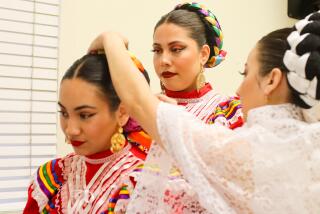Popular College Class Teaches Serious Side of Fun, Games
The class began with a group rendition of the hula. Wearing Hawaiian leis of various colors, the students swayed seductively to the gentle strains of the hukilau .
Then the serious stuff of academia commenced. Moving to the grass outside, they engaged in a series of lively Hawaiian games, ranging from a chest-pushing contest to one in which two combatants ceremoniously bite their own little fingers for 10 seconds, then hook them together and attempt to pull each other off balance.
“I made her think she was going to win and then she fell,” said speech major Lorrie Remus, 21, in explaining her victory over a classmate before the cheering throng.
Popular Course
David Doherty, a 22-year-old English major, said: “This is what makes me get up in the morning.”
Indeed, lots of other students at California State University, Long Beach, count Recreation 320--more popularly known as the Universality of Play--among their favorite courses. Drawn from majors as diverse as chemical engineering and music, the students hear about the fast-filling course mostly by word of mouth. Unlike other classes, they say, this one is fun, helps its participants get to know each other and requires direct physical involvement.
“We are concerned about attrition on this campus,” said Jack Minar, who teaches the course. “We have attrition because no one lightens up out here.”
But there is also a more serious side to the 3-unit course, which satisfies a general education requirement called “self-integration.” Specifically, Minar said, it is to imbue students with an appreciation of the importance of play in human life and world culture, as well as contribute to their understanding of other cultures by emphasizing the similarities of recreational activities throughout the world.
“We all have the same basic drive to play, and it’s an important part of our nature,” Minar said. “It shouldn’t be shunted aside as we get older.”
The professor drives that point home in a number of ways. Besides frequent participatory demonstrations of game-playing from other cultures, he lectures and assigns readings on theories of recreation, administers traditional written exams on the material and even gives homework assignments. Among this semester’s tasks are to observe and report on at least three situations in which individuals or groups engage in play behavior, and to interview someone over 70 about the kind of recreational activities he or she engaged in as a child.
Contrary to some perceptions, Minar said, the course is not for shirkers. “It’s tough,” he said, adding that only about 10% of the 36 class members are likely to get A’s, with the average student receiving a C+ or B-.
Besides fostering an appreciation of other cultures, he said, the course helps promote a sense of community on an often impersonal campus and enhances creativity by putting students in a receptive frame of mind. “Play is the most essential thing we have,” he said. “It’s what we live for; you can trace almost every important idea in history to a recreational mood.”
Some of the students describe the course in less lofty terms.
“It’s a kick-back class,” said journalism major Juli Ruzich, 18, shortly after being thrown to the ground during an exercise called Crack the Whip. “It’s fun.”
“You think of college as a stressful environment,” added Melissa Johnson, also 18, “but this makes everyone relaxed. It’s the only class I’ve never missed.”
Minar, for his part, is philosophical about the obvious popularity of the course, which meets twice a week at 8 a.m. “When you walk out with a smile on your face,” he said, “it might change the rest of your day.”
More to Read
Sign up for Essential California
The most important California stories and recommendations in your inbox every morning.
You may occasionally receive promotional content from the Los Angeles Times.









